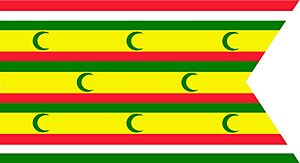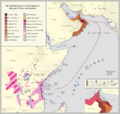Omani Empire facts for kids
Quick facts for kids
Omani Empire
|
|||||||||||||
|---|---|---|---|---|---|---|---|---|---|---|---|---|---|
| 1696–1856 | |||||||||||||

Chronological map of the Omani Empire and Zanzibar
|
|||||||||||||
| Capital |
|
||||||||||||
| Common languages | Official: Arabic Regional: Persian Swahili Balochi English French Malagasy |
||||||||||||
| Religion | Dominant: Ibadi Islam Minor: Sunni Islam Shia Islam Christianity |
||||||||||||
| Demonym(s) | Omani | ||||||||||||
| Government | Monarchy | ||||||||||||
| Yaruba Dynasty | |||||||||||||
|
• 1692–1711
|
Saif bin Sultan (first) | ||||||||||||
|
• 1711–1718
|
Sultan bin Saif II | ||||||||||||
|
• 1718–1719
|
Saif bin Sultan II | ||||||||||||
| Al Busaid Dynasty | |||||||||||||
|
• 1744–1778
|
Ahmad bin Said | ||||||||||||
|
• 1778–1783
|
Said bin Ahmed | ||||||||||||
|
• 1783–1793
|
Hamad bin Said | ||||||||||||
|
• 1792–1804
|
Sultan bin Ahmed | ||||||||||||
|
• 1805–1806
|
Badr bin Seif | ||||||||||||
|
• 1806–1856
|
Said bin Sultan (last) | ||||||||||||
| History | |||||||||||||
|
• Occupation of Fort Jesus by
Saif bin Sultan |
1696 | ||||||||||||
|
• Civil war
in Oman |
1718 | ||||||||||||
|
• Persian invasion
of Sohar |
1742 | ||||||||||||
|
• Al Busaid Dynasty
took over |
1749 | ||||||||||||
|
• Treaty with the
United States |
1837 | ||||||||||||
| 1856 | |||||||||||||
| Population | |||||||||||||
|
• 1870 estimate
|
367,400 | ||||||||||||
| Currency |
|
||||||||||||
|
|||||||||||||
The Omani Empire (Arabic: الْإِمْبَرَاطُورِيَّة الْعُمَانِيَّة) was a powerful sea-based empire. It competed with Portugal and Britain for trade and power. This happened in the Persian Gulf and Indian Ocean.
The empire grew strong in the 1700s. At its peak in the 1800s, its control reached far. It stretched across the Strait of Hormuz to modern-day Iran and Pakistan. It also went as far south as Cape Delgado in Africa.
After Said bin Sultan died in 1856, the empire split. His sons divided it into two separate sultanates. One was the Sultanate of Zanzibar in Africa. The other was the Sultanate of Muscat and Oman in Asia.
Contents
History of the Omani Empire
How Oman Became a Strong Power
Muscat was a very important city for trade. It was controlled by the Portuguese Empire from 1507 to 1650. However, the Portuguese could not control all of Oman. In the mid-1600s, Omani tribes managed to push the Portuguese out of Muscat.
In 1696, under Saif bin Sultan, an Omani fleet attacked Mombasa. They surrounded the Portuguese Fort Jesus. About 2,500 people were hiding inside the fort. The siege lasted 33 months. The people inside surrendered to the Omanis because they were starving.
By 1783, the Omani Empire had grown eastward. It reached Gwadar in what is now Pakistan. The Omanis also kept attacking Portuguese bases in western India. But they did not manage to conquer any of them. In the north, the Omanis moved into the Persian Gulf. They took Bahrain from the Persians and held it for several years. Omani power also spread south. This included many Omani people moving to Zanzibar.
The Ya'rubid Dynasty's Achievements
The Ya'rubids ruled from 1624 to 1719. They built a strong and well-organized state. Before them, the Portuguese had caused problems for Arabian sea trade. The Omanis challenged this and brought back their traditional role as sea traders. This led to big economic and political improvements.
Agriculture in Oman greatly improved under Saif bin Sultan. He is famous for bringing water to the inner parts of Oman. He also encouraged Omani Arabs to move to the coast. They planted date palms in the coastal Al Batinah Region. The town of Al Hamra also got a better irrigation system. This was thanks to a new large falaj (water channel). The Ya'rubid dynasty invested a lot in farming and settlements.
Saif bin Sultan also built new schools. He made the castle of Rustaq his home. He added the Burj al Riah wind tower there. Saif bin Sultan died on October 4, 1711. He was buried in a grand tomb at Rustaq castle. Later, a Wahhabi general destroyed his tomb. When he died, he was very rich. He owned 28 ships, 700 male slaves, and one-third of Oman's date trees.
His son, Sultan bin Saif II, took over (1711–1718). He made his capital at Al-Hazm. This was on the road from Rustaq to the coast. Today, Al-Hazm is just a village. But you can still see the remains of a great fortress he built around 1710. His tomb is also there.
Oman's Alliance with Great Britain
Sultan bin Ahmad took control after his nephew died. He made the Omani fleet even stronger. He added many gunships and fast cargo vessels. He also needed a powerful friend. This friend would help him get back Mombasa from the Mazrui clan. He also needed help fighting a movement from what is now Saudi Arabia. And he wanted to keep the Qasimi tribes from the Persian city of Lengeh out of Oman.
He found this strong friend in Great Britain. In the late 1700s, Britain was fighting France. The British knew that the French emperor, Napoleon Bonaparte, planned to march through Persia. Napoleon wanted to capture Muscat on his way to invade India. In 1798, Britain and Oman signed a Treaty of Commerce and Navigation.
Sultan bin Ahmad promised to support British interests in India. His lands became off-limits to the French. He let the British East India Company set up the first trading post in the Persian Gulf. A British consul was also sent to Muscat. The British had another reason for the treaty. They wanted to pressure the Sultan to stop slavery. Slavery had been made illegal in England in 1772.
At this time, the slave trade from Africa to Oman was still very active. Zanzibar became an even more important trade center. This happened when ivory supplies from Mozambique to India stopped. This was due to high Portuguese export taxes. Traders simply sent their ivory through Zanzibar instead. Omani warships were often fighting in the Gulf. This kept Sultan bin Ahmad very busy. In 1804, during one of his trips on a ship in the Persian Gulf, Sayyid Sultan was shot. He was buried in Lengeh.
Oman's Relationship with the United States
On September 21, 1833, Oman and the United States signed an important treaty. It was a treaty of friendship and trade. This was the second trade treaty the US made with an Arab state. (Morocco was the first in 1820). Both the United States and Oman benefited from this. The US did not want to control any land in the Middle East. It was only interested in trade, unlike Britain and France.
On April 13, 1840, the ship Al-Sultanah arrived in New York. This was the first time an Arab envoy visited the New World. Its crew of fifty-six Arab sailors caused a lot of excitement. New York City had three hundred thousand residents at that time. Al-Sultanah carried ivory, Persian rugs, spices, coffee, and dates. It also had fancy gifts for President Martin Van Buren.
The visit of Al-Sultanah lasted almost four months. The envoy, Ahmad bin Na'aman Al Kaabi, and his officers were hosted by important people. They received special honors and toured New York City. They saw areas that would later become Arab-speaking neighborhoods. Among Bin Na'aman's hosts was Commodore Cornelius Vanderbilt. At Vanderbilt's home, he met Governor William H. Seward and Vice President Richard Mentor Johnson. Al Kaabi's visit to America was very successful. When he prepared to leave, the United States fully repaired Al-Sultanah. They also gave him gifts for his Sultan.
Said bin Sultan of the Al-Busaid Dynasty
Said bin Sultan was the son of Sultan bin Ahmad. Sultan bin Ahmad ruled Oman from 1792 to 1804. He died in 1804 during a trip to Basra. He named Mohammed bin Nasir bin Mohammed al-Jabry as the person to rule until his sons were old enough. Mohammed also became the guardian of his two sons, Salim bin Sultan and Said bin Sultan.
Sultan's brother, Qais bin Ahmad, who ruled Sohar, tried to take power. In early 1805, Qais and his brother Mohammed marched south. They went along the coast to Muttrah, which they easily captured. Qais then began to surround Muscat. Mohammed bin Nasir tried to pay Qais to leave, but it did not work.
Mohammed bin Nasir asked Badr bin Saif for help. After some fights, Qais had to go back to Sohar. Badr bin Saif became the real ruler. He was allied with the Wahhabis. Badr bin Saif became very unpopular. To get Said and Salim out of the way, Badr bin Saif made Salim bin Sultan governor of Al Maşna‘ah. He made Said bin Sultan governor of Barka.
In 1806, Said bin Sultan tricked Badr bin Saif into coming to Barka. He then murdered him nearby. Said was declared the ruler of Oman. There are different stories about what happened. But it seems clear that Said started the attack. His supporters finished the job. The people cheered Said as a hero. They saw him as someone who freed them from the Wahhabis, who then left the country. Qais bin Ahmad immediately supported Said. Said was worried about how the Wahhabis would react. So, he blamed Mohammed bin Nasir for the murder.
In 1832, Said bin Sultan moved the capital from Oman to Zanzibar. At that time, the empire's African lands stretched along the Swahili coast. They went as far as 12 miles south of the Ruvuma River in Mozambique. The empire mainly governed the coast. But it also controlled many African tributary states. It appointed governors for areas further inland.
The Decline of the Empire
In 1798, Britain and Oman signed a Treaty of Friendship. This treaty meant Britain would protect the Sultan's rule. But in 1856, there was a problem about who would rule next. The Omani Empire then split into two parts. These were the Sultanate of Oman and Muscat and the Sultanate of Zanzibar. Later, in 1891, the Sultanate of Oman and Muscat became a British Protectorate. This meant the Sultan controlled the Muscat coast. But an Imam governed the interior from Nizwa.
Images for kids





